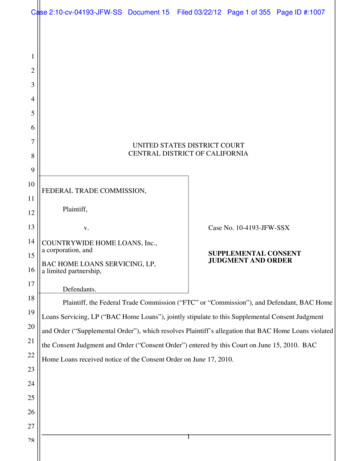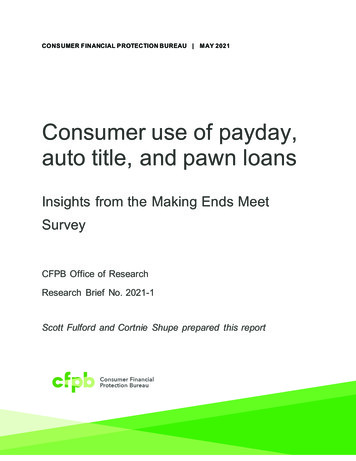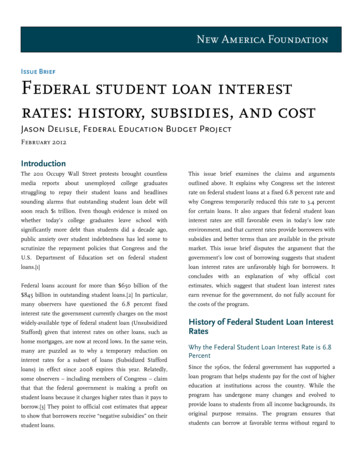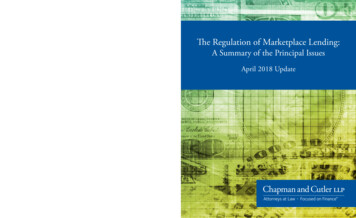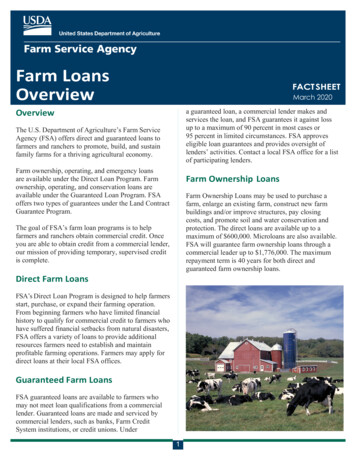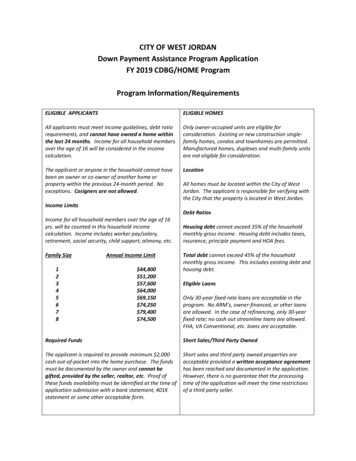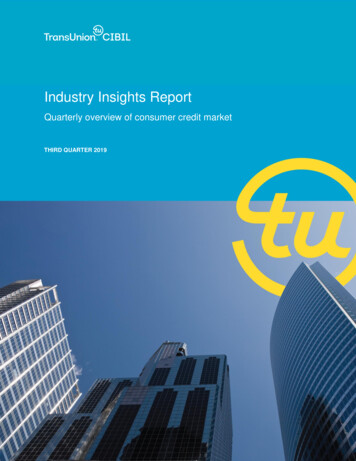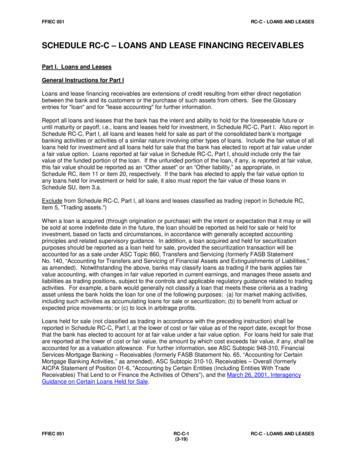
Transcription
FFIEC 051RC-C - LOANS AND LEASESSCHEDULE RC-C – LOANS AND LEASE FINANCING RECEIVABLESPart I. Loans and LeasesGeneral Instructions for Part ILoans and lease financing receivables are extensions of credit resulting from either direct negotiationbetween the bank and its customers or the purchase of such assets from others. See the Glossaryentries for "loan" and for "lease accounting" for further information.Report all loans and leases that the bank has the intent and ability to hold for the foreseeable future oruntil maturity or payoff, i.e., loans and leases held for investment, in Schedule RC-C, Part I. Also report inSchedule RC-C, Part I, all loans and leases held for sale as part of the consolidated bank’s mortgagebanking activities or activities of a similar nature involving other types of loans. Include the fair value of allloans held for investment and all loans held for sale that the bank has elected to report at fair value undera fair value option. Loans reported at fair value in Schedule RC-C, Part I, should include only the fairvalue of the funded portion of the loan. If the unfunded portion of the loan, if any, is reported at fair value,this fair value should be reported as an “Other asset” or an “Other liability,” as appropriate, inSchedule RC, item 11 or item 20, respectively. If the bank has elected to apply the fair value option toany loans held for investment or held for sale, it also must report the fair value of these loans inSchedule SU, item 3.a.Exclude from Schedule RC-C, Part I, all loans and leases classified as trading (report in Schedule RC,item 5, "Trading assets.")When a loan is acquired (through origination or purchase) with the intent or expectation that it may or willbe sold at some indefinite date in the future, the loan should be reported as held for sale or held forinvestment, based on facts and circumstances, in accordance with generally accepted accountingprinciples and related supervisory guidance. In addition, a loan acquired and held for securitizationpurposes should be reported as a loan held for sale, provided the securitization transaction will beaccounted for as a sale under ASC Topic 860, Transfers and Servicing (formerly FASB StatementNo. 140, “Accounting for Transfers and Servicing of Financial Assets and Extinguishments of Liabilities,"as amended). Notwithstanding the above, banks may classify loans as trading if the bank applies fairvalue accounting, with changes in fair value reported in current earnings, and manages these assets andliabilities as trading positions, subject to the controls and applicable regulatory guidance related to tradingactivities. For example, a bank would generally not classify a loan that meets these criteria as a tradingasset unless the bank holds the loan for one of the following purposes: (a) for market making activities,including such activities as accumulating loans for sale or securitization; (b) to benefit from actual orexpected price movements; or (c) to lock in arbitrage profits.Loans held for sale (not classified as trading in accordance with the preceding instruction) shall bereported in Schedule RC-C, Part I, at the lower of cost or fair value as of the report date, except for thosethat the bank has elected to account for at fair value under a fair value option. For loans held for sale thatare reported at the lower of cost or fair value, the amount by which cost exceeds fair value, if any, shall beaccounted for as a valuation allowance. For further information, see ASC Subtopic 948-310, FinancialServices-Mortgage Banking – Receivables (formerly FASB Statement No. 65, “Accounting for CertainMortgage Banking Activities,” as amended), ASC Subtopic 310-10, Receivables – Overall (formerlyAICPA Statement of Position 01-6, "Accounting by Certain Entities (Including Entities With TradeReceivables) That Lend to or Finance the Activities of Others"), and the March 26, 2001, InteragencyGuidance on Certain Loans Held for Sale.FFIEC 051RC-C-1(3-19)RC-C - LOANS AND LEASES
FFIEC 051RC-C - LOANS AND LEASESGeneral Instructions for Part I (cont.)Institutions that have not adopted FASB Accounting Standards Update No. 2016-13 (ASU 2016-13),which governs the accounting for credit losses, should report loans and leases held for investment in thisschedule without any deduction for the allowance for loan and lease losses or any allocated transfer riskreserves related to loans and leases, which are to be reported in Schedule RC, item 4.c, "Allowance forloan and lease losses." Institutions that have adopted ASU 2016-13 should report loans and leases heldfor investment in this schedule without any deduction for allowances for credit losses on loans and leasesor any allocated transfer risk reserves related to loans and leases, which are to be reported inSchedule RC, item 4.c, "Allowance for loan and lease losses."Each item in this schedule should be reported net of (1) unearned income (to the extent possible) and (2)deposits accumulated for the payment of personal loans (hypothecated deposits). Net unamortized loanfees represent an adjustment of the loan yield, and shall be reported in this schedule in the same manneras unearned income on loans, i.e., deducted from the related loan balances (to the extent possible) ordeducted from total loans in Schedule RC-C, Part I, item 11, "LESS: Any unearned income on loansreflected in items 1-9 above." Net unamortized direct loan origination costs shall be added to the relatedloan balances in each item in this schedule. (See the Glossary entry for "loan fees" for furtherinformation.)For institutions that have not adopted ASU 2016-13, "purchased credit-impaired loans" are loansaccounted for in accordance with ASC Subtopic 310-30, Receivables – Loans and Debt SecuritiesAcquired with Deteriorated Credit Quality (formerly AICPA Statement of Position 03-3, "Accounting forCertain Loans or Debt Securities Acquired in a Transfer"), that a bank has purchased, including thoseacquired in a purchase business combination, where there is evidence of deterioration of credit qualitysince the origination of the loan and it is probable, at the purchase date, that the bank will be unable tocollect all contractually required payments receivable. Neither the accretable yield nor the nonaccretabledifference associated with purchased credit-impaired loans should be reported as unearned income inSchedule RC-C, Part I, item 11. In addition, the nonaccretable difference must not be recognized as anadjustment of yield, loss accrual, or valuation allowance.For institutions that have adopted ASU 2016-13, “purchased credit-deteriorated loans” are acquiredindividual loans (or acquired groups of loans with similar risk characteristics) accounted for in accordancewith ASC Topic 326, Financial Instruments‒Credit Losses, that, as of the date of acquisition, haveexperienced a more-than-insignificant deterioration in credit quality since origination, as determined bythe acquiring institution’s assessment. Unless accounted for at fair value under a fair value option,purchased credit-deteriorated loans should be reported in Schedule RC-C, Part I, at amortized cost.Any noncredit discount or premium on a purchased credit-deteriorated loan should not be reported asunearned income in Schedule RC-C, Part I, item 11.If, as a result of a change in circumstances, the bank regains control of a loan previously accountedfor appropriately as having been sold because one or more of the conditions for sale accounting inASC Topic 860 are no longer met, such a change should be accounted for in the same manner as apurchase of the loan from the former transferee (purchaser) in exchange for liabilities assumed. Therebooked loan must be reported as a loan asset in Schedule RC-C, Part I, either as a loan held for sale ora loan held for investment, based on facts and circumstances, in accordance with generally acceptedaccounting principles. This accounting and reporting treatment applies, for example, to U.S.Government-guaranteed or -insured residential mortgage loans backing Government National MortgageAssociation (GNMA) mortgage-backed securities that a bank services after it has securitized the loans ina transfer accounted for as a sale. If and when individual loans later meet delinquency criteria specifiedby GNMA, the loans are eligible for repurchase, the bank is deemed to have regained effective controlover these loans, and the delinquent loans must be brought back onto the bank's books as loan assets.All loans should be categorized in Schedule RC-C, Part I, according to security, borrower, or purpose.All loans satisfying the criteria in the Glossary entry for “Loan secured by real estate” (except those toFFIEC 051RC-C-2(3-19)RC-C - LOANS AND LEASES
FFIEC 051RC-C - LOANS AND LEASESGeneral Instructions for Part I (cont.)states and political subdivisions in the U.S.) should be categorized as “Loans secured by real estate” inSchedule RC-C, part I. Loans secured by other collateral, such as securities, inventory, or automobiles,would require further examination of both purpose and borrower to properly categorize the loans inSchedule RC-C, part I. For loan categories in Schedule RC-C, part I, that include certain loans toindividuals, the term “individual” may include a trust or other entity that acts on behalf of (or in place of) anindividual or a group of individuals for purposes of obtaining the loan. Loans covering two or morecategories are sometimes difficult to categorize. In such instances, categorize the entire loan accordingto the major criterion.Report in Schedule RC-C, Part I, all loans and leases on the books of the reporting bank even if on thereport date they are past due and collection is doubtful. Exclude any loans or leases the bank has sold orcharged off. Also exclude assets received in full or partial satisfaction of a loan or lease (unless the assetreceived is itself reportable as a loan or lease) and any loans for which the bank has obtained physicalpossession of the underlying collateral, regardless of whether formal foreclosure or repossessionproceedings have been instituted against the borrower. Refer to the Glossary entries for "troubled debtrestructurings" and "foreclosed assets" for further discussion of these topics.FFIEC 051RC-C-2a(3-19)RC-C - LOANS AND LEASES
This page intentionally left blank.
FFIEC 051RC-C - LOANS AND LEASESGeneral Instructions for Part I (cont.)When a bank acquires either (1) a portion of an entire loan that does not meet the definition of aparticipating interest (i.e., a nonqualifying loan participation) or (2) a qualifying participating interest in atransfer that does not does not meet all of the conditions for sale accounting, it should normally report theloan participation or participating interest in Schedule RC, item 4.b, “Loans and leases held forinvestment.” The bank also should report the loan participation or participating interest in ScheduleRC-C, Part I, in the loan category appropriate to the underlying loan, e.g., as a “commercial and industrialloan” in item 4 or as a “loan secured by real estate” in item 1. See the Glossary entry for “transfers offinancial assets” for further information.Exclude, for purposes of this schedule, the following:(1) Federal funds sold, i.e., all loans of immediately available funds that mature in one business day orroll over under a continuing contract, excluding funds lent in the form of securities purchased underagreements to resell. Report federal funds sold in Schedule RC, item 3.a. However, report overnightlending for commercial and industrial purposes as loans in this schedule.(2) Lending transactions in the form of securities purchased under agreements to resell (report inSchedule RC, item 3.b, "Securities purchased under agreements to resell").(3) All holdings of commercial paper (report in Schedule RC, item 5, if held for trading; report inSchedule RC-B, item 4.b, “Other mortgage-backed securities,” item 5.a, "Asset-backed securities,"or item 6, "Other debt securities," as appropriate, if held for purposes other than trading).(4) Contracts of sale or other loans indirectly representing other real estate (report in Schedule RC,item 7, "Other real estate owned").(5) Undisbursed loan funds, sometimes referred to as incomplete loans or loans in process, unless theborrower is liable for and pays the interest thereon. If interest is being paid by the borrower on theundisbursed proceeds, the amount of such undisbursed funds should be included in both loans anddeposits. (Do not include loan commitments that have not yet been taken down, even if fees havebeen paid; see Schedule RC-L, item 1.)Item Instructions for Part IItem No.1Caption and InstructionsLoans secured by real estate. Report all loans that meet the definition of a “loan securedby real estate.” See the Glossary entry for "loan secured by real estate" for the definition ofthis term. Institutions should report in items 1.a.(1) through 1.e.(2) a nine-categorybreakdown of loans secured by real estate.Include all loans (other than those to states and political subdivisions in the U.S.), regardlessof purpose and regardless of whether originated by the bank or purchased from others, thatare secured by real estate at origination as evidenced by mortgages, deeds of trust, landcontracts, or other instruments, whether first or junior liens (e.g., equity loans, secondmortgages) on real estate.FFIEC 051RC-C-3(6-18)RC-C - LOANS AND LEASES
FFIEC 051RC-C - LOANS AND LEASESPart I. (cont.)Item No.Caption and Instructions1(cont.)Include as loans secured by real estate:(1) Loans secured by residential properties that are guaranteed by the Farmers HomeAdministration (FmHA) and extended, collected, and serviced by a party other than theFmHA.(2) Loans secured by properties and guaranteed by governmental entities in foreigncountries.(3) Participations in pools of Federal Housing Administration (FHA) Title I home improvementloans that are secured by liens (generally, junior liens) on residential properties.(4) Loans secured by real estate that are guaranteed by the Small Business Administration(SBA). Include SBA “Guaranteed Interest Certificates,” which represent a beneficialinterest in the entire SBA-guaranteed portion of an individual loan, provided the loan is aloan secured by real estate. (Exclude SBA “Guaranteed Loan Pool Certificates,” whichrepresent an undivided interest in a pool of SBA-guaranteed portions of loans. SBA“Guaranteed Loan Pool Certificates” should be reported as securities in Schedule RC-B,item 2, or, if held for trading, in Schedule RC, item 5.)Exclude from loans secured by real estate:(1) Obligations (other than securities and leases) of states and political subdivisions in theU.S. that are secured by real estate (report in Schedule RC-C, Part I, item 8).(2) All loans and sales contracts indirectly representing other real estate (report inSchedule RC, item 7, "Other real estate owned").(3) Loans to real estate companies, real estate investment trusts, mortgage lenders, andforeign non-governmental entities that specialize in mortgage loan originations and thatservice mortgages for other lending institutions when the real estate mortgages or similarliens on real estate are not sold to the bank but are merely pledged as collateral (report inSchedule RC-C, Part I, item 2, "Loans to depository institutions and acceptances of otherbanks," or item 9.a, “Loans to nondepository financial institutions,” as appropriate).(4) Bonds issued by the Federal National Mortgage Association or by the Federal HomeLoan Mortgage Corporation that are collateralized by residential mortgages (report inSchedule RC-B, item 2, “U.S. Government agency and sponsored agency obligations").(5) Pooled residential mortgages for which participation certificates have been issued orguaranteed by the Government National Mortgage Association, the Federal NationalMortgage Association, or the Federal Home Loan Mortgage Corporation (report inSchedule RC-B, item 4.a). However, if the reporting bank is the seller-servicer of theresidential mortgages backing such securities and, as a result of a change incircumstances, it must rebook any of these mortgages because one or more of theconditions for sale accounting in ASC Topic 860, Transfers and Servicing (formerlyFASB Statement No. 140, “Accounting for Transfers and Servicing of Financial Assetsand Extinguishments of Liabilities,” as amended by FASB Statement No. 166,“Accounting for Transfers of Financial Assets”), are no longer met, the rebookedmortgages should be included in Schedule RC-C, Part I, as loans secured by real estate.FFIEC 051RC-C-4(6-18)RC-C - LOANS AND LEASES
FFIEC 051RC-C - LOANS AND LEASESPart I. (cont.)Item No.1.aCaption and InstructionsConstruction, land development, and other land loans. Report in the appropriate subitemloans secured by real estate made to finance (a) land development (i.e., the process ofimproving land – laying sewers, water pipes, etc.) preparatory to erecting new structures or(b) the on-site construction of industrial, commercial, residential, or farm buildings. Forpurposes of this item, "construction" includes not only construction of new structures, but alsoadditions or alterations to existing structures and the demolition of existing structures to makeway for new structures.Also include in this item:(1) Loans secured by vacant land, except land known to be used or usable for agriculturalpurposes, such as crop and livestock production (which should be reported inSchedule RC-C, Part I, item 1.b, below, as loans secured by farmland).(2) Loans secured by real estate the proceeds of which are to be used to acquire andimprove developed and undeveloped property.(3) Loans made under Title I or Title X of the National Housing Act that conform to thedefinition of construction stated above and that are secured by real estate.Loans written as combination construction-permanent loans secured by real estate should bereported in this item until construction is completed or principal amortization payments begin,whichever comes first. When the first of these events occurs, the loans should begin to bereported in the real estate loan category in Schedule RC-C, Part I, item 1, appropriate to thereal estate collateral. For purposes of these reports, a combination construction-permanentloan arises when the lender enters into a contractual agreement with the original borrower atthe time the construction loan is originated to also provide the original borrower withpermanent financing that amortizes principal after construction is completed and a certificateof occupancy is obtained (if applicable). This construction-permanent loan structure isintended to apply to situations where, at the time the construction loan is originated, theoriginal borrower: Is expected to be the owner-occupant of the property upon completion of constructionand receipt of a certificate of occupancy (if applicable), for example, where the financingis being provided to the original borrower for the construction and permanent financing ofthe borrower’s residence or place of business, orIs not expected to be the owner-occupant of the property, but repayment of thepermanent loan will be derived from rental income associated with the property beingconstructed after receipt of a certificate of occupancy (if applicable) rather than from thesale of the property being constructed.All construction loans secured by real estate, other than combination construction-permanentloans as described above, should continue to be reported in this item after construction iscompleted unless and until (1) the loan is refinanced into a new permanent loan by thereporting bank or is otherwise repaid, (2) the bank acquires or otherwise obtains physicalpossession of the underlying collateral in full satisfaction of the debt, or (3) the loan ischargedFFIEC 051RC-C-5(3-17)RC-C - LOANS AND LEASES
FFIEC 051RC-C - LOANS AND LEASESPart I. (cont.)Item No.Caption and Instructions1.a(cont.)off. For purposes of these reports, a construction loan is deemed to be refinanced into a newpermanent loan only if the bank originates: An amortizing permanent loan to a new borrower (unrelated to the original borrower) whohas purchased the real property, orA prudently underwritten new amortizing permanent loan at market terms to the originalborrower – including an appropriate interest rate, maturity, and loan-to-value ratio – thatis no longer dependent on the sale of the property for repayment. The loan should havea clearly identified ongoing source of repayment sufficient to service the requiredprincipal and interest payments over a reasonable and customary period relative to thetype of property securing the new loan. A new loan to the original borrower not meetingthese criteria (including a new loan on interest-only terms or a new loan with a short-termballoon maturity that is inconsistent with the ongoing source of repayment criterion)should continue to be reported as a “Construction, land development, and other landloan” in the appropriate subitem of Schedule RC-C, Part I, item 1.a.Exclude loans to finance construction and land development that are not secured by realestate (report in other items of Schedule RC-C, Part I, as appropriate).1.a.(1)1-4 family residential construction loans. Report the amount outstanding of 1-4 familyresidential construction loans, i.e., loans for the purpose of constructing 1-4 family residentialproperties, which will secure the loan. The term “1-4 family residential properties” is definedin Schedule RC-C, Part I, item 1.c, below. “1-4 family residential construction loans” include: FFIEC 051Construction loans to developers secured by tracts of land on which 1-4 family residentialproperties, including townhouses, are being constructed.Construction loans secured by individual parcels of land on which single 1-4 familyresidential properties are being constructed.Construction loans secured by single-family dwelling units in detached or semidetachedstructures, including manufactured housing.Construction loans secured by duplex units and townhouses, excluding garden apartmentprojects where the total number of units that will secure the permanent mortgage isgreater than four.Combination land and construction loans on 1-4 family residential properties, regardlessof the current stage of construction or development.Combination construction-permanent loans on 1-4 family residential properties untilconstruction is completed or principal amortization payments begin, whichever comesfirst.Loans secured by apartment buildings undergoing conversion to condominiums,regardless of the extent of planned construction or renovation, where repayment willcome from sales of individual condominium dwelling units, which are 1-4 familyresidential properties.Bridge loans to developers on 1-4 family residential properties where the buyer will notassume the same loan, even if construction is completed or principal amortizationpayments have begun.RC-C-6(3-17)RC-C - LOANS AND LEASES
FFIEC 051RC-C - LOANS AND LEASESPart I. (cont.)Item No.Caption and Instructions1.a.(2)Other construction loans and all land development and other land loans. Report theamount outstanding of all construction loans for purposes other than constructing 1-4 familyresidential properties, all land development loans, and all other land loans. Include loans forthe development of building lots and loans secured by vacant land, unless the same loanfinances the construction of 1-4 family residential properties on the property.1.bSecured by farmland. Report loans secured by farmland and improvements thereon, asevidenced by mortgages or other liens. Farmland includes all land known to be used orusable for agricultural purposes, such as crop and livestock production. Farmland includesgrazing or pasture land, whether tillable or not and whether wooded or not.Include loans secured by farmland that are guaranteed by the Farmers Home Administration(FmHA) or by the Small Business Administration (SBA) and that are extended, serviced, andcollected by any party other than FmHA or SBA.Exclude loans for farm property construction and land development purposes (report inSchedule RC-C, Part I, item 1.a).1.cSecured by 1-4 family residential properties. Report in the appropriate subitem open-endand closed-end loans secured by real estate as evidenced by mortgages (FHA, FmHA, VA,or conventional) or other liens on:(1) Nonfarm property containing 1-to-4 dwelling units (including vacation homes) or morethan four dwelling units if each is separated from other units by dividing walls that extendfrom ground to roof (e.g., row houses, townhouses, or the like).(2) Mobile homes where (a) state laws define the purchase or holding of a mobile home asthe purchase or holding of real property and where (b) the loan to purchase the mobilehome is secured by that mobile home as evidenced by a mortgage or other instrument onreal property.(3) Individual condominium dwelling units and loans secured by an interest in individualcooperative housing units, even if in a building with five or more dwelling units.(4) Housekeeping dwellings with commercial units combined where use is primarilyresidential and where only 1-to-4 family dwelling units are involved.A home equity line of credit (HELOC) is a revolving open-end line of credit secured by a lienon a 1-to-4 family residential property that generally provides a draw period followed by arepayment period. During the draw period, a borrower has revolving access to unusedamounts under a specified line of credit. During the repayment period, the borrower can nolonger draw on the line of credit and the outstanding principal is either due immediately in aballoon payment or repaid over the remaining term through monthly payments. HELOCs inthe draw period or in the repayment period should be reported in Schedule RC-C, Part I,item 1.c.(1).1 Beginning June 30, 2021, revolving open-end lines of credit that are no longer1All HELOCs that convert to non-revolving, closed-end status on or after January 1, 2021, must be reported asopen-end loans in item 1.c.(1). An institution that, as of March 31, 2020, reports HELOCs that convert tonon-revolving, closed-end status as closed-end loans in Schedule RC-C, Part I, item 1.c.(2)(a) or 1.c.(2)(b),as appropriate, may continue to report HELOCs that convert on or before December 31, 2020, as closed-end loans inCall Reports for report dates after that date. Alternatively, the institution may choose to begin reporting some or all ofthese closed-end HELOCs as open-end loans in item 1.c.(1) as of the March 31, 2020, or any subsequent reportdate, provided this reporting treatment is consistently applied.FFIEC 051RC-C-7(3-20)RC-C - LOANS AND LEASES
FFIEC 051RC-C - LOANS AND LEASESPart I. (cont.)Item No.Caption and Instructions1.c(cont.)in the draw period and have converted to non-revolving closed-end status also should bereported in Schedule RC-C, Part I, Memorandum item 16 (in the June and December reportsonly).Reverse 1-4 family residential mortgages should be reported in the appropriate subitembased on whether they are closed-end or open-end mortgages. A reverse mortgage is anarrangement in which a homeowner borrows against the equity in his/her home and receivescash either in a lump sum or through periodic payments. However, unlike a traditionalmortgage loan, no payment is required until the borrower no longer uses the home as his orher principal residence. Cash payments to the borrower after closing, if any, and accruedinterest are added to the principal balance. These loans may have caps on their maximumprincipal balance or they may have clauses that permit the cap on the maximum principalbalance to be increased under certain circumstances. Homeowners generally have one ofthe following options for receiving tax free loan proceeds from a reverse mortgage: (1) onelump sum payment; (2) a line of credit; (3) fixed monthly payments to homeowner either for aspecified term or for as long as the homeowner lives in the home; or (4) a combination of theabove.Reverse mortgages that provide for a lump sum payment to the borrower at closing, with noability for the borrower to receive additional funds under the mortgage at a later date, shouldbe reported as closed-end loans in Schedule RC-C, Part I, item 1.c.(2). Normally, closed-endreverse mortgages are first liens and would be reported in Schedule RC-C, Part I,item 1.c.(2)(a). Reverse mortgages that are structured like home equity lines of credit inthat they provide the borrower with additional funds after closing (either as fixed monthlypayments, under a line of credit, or both) should be reported as open-end loans inSchedule RC-C, Part I, item 1.c.(1). Open-end reverse mortgages also are normally firstliens. Where there is a combination of both a lump sum payment to the borrower at closingand payments after the closing of the loan, the reverse mortgage should be reported as anopen-end loan in Schedule RC-C, Part I, item 1.c.(1).Exclude loans for 1-to-4 family residential property construction and land developmentpurposes (report in Schedule RC-C, Part I, item 1.a.(1)). Also exclude loans secured byvacant lots in established single-family residential sections or in areas set aside primarily for1-to-4 family homes (report in Schedule RC-C, Part I, item 1.a).1.c.(1)Revolving, open-end loans secured by 1-4 family residential properties and extendedunder lines of credit. Report the amount outstanding under revolving, open-end lines ofcredit secured by 1-to-4 family residential properties, i.e., HELOCs.Include revolving, open-end lines of credit secured by 1-to-4 family residential propertiesfor which the draw periods have ended and the loans have converted to non-revolvingclosed-end status.1 After their conversion, such loans also should be reported inSchedule RC-C, Part I, Memorandum item 16,
investment." The bank also should report the loan participation or participating interest in Schedule RC-C, Part I, in the loan category appropriate to the underlying loan, e.g., as a "commercial and industrial loan" in item 4 or as a "loan secured by real estate" in item 1. See the Glossary entry for "transfers of

